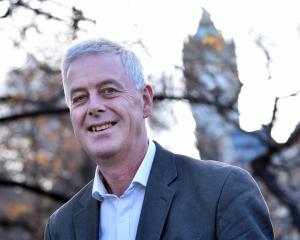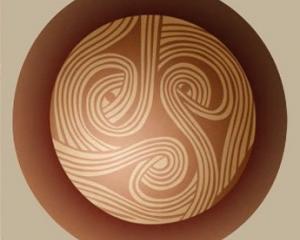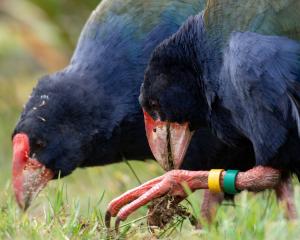
Sir Paul Callaghan considers himself a lucky man. Not because he's the leader of the team that has won this year's Prime Minister's Science Prize of $500,000.
He's won prizes before, plenty of them - the Ampere Prize, the Rutherford Medal and the Gunther Laukien Prize among them.
Neither does he link his luck to the fact that his team's work in the rarefied world of nuclear magnetic resonance is so widely published - 250 scientific papers between the five of them with a citation "h-index" of 46, putting them up with Nobel Prize winners.
"I've been hugely well recognised and I sometimes wonder why - I've been lucky that way," he says with typical modesty.
The reason Sir Paul regards himself as lucky is that he's still here. Diagnosed with bowel cancer in 2008, he had surgery and chemotherapy, but the outlook wasn't great.
"The tumour had got through the wall and spread cells into my abdominal cavity. I had multiple tumours throughout my peritoneum."
It was a fatal condition with no cure.
"So I was told to organise my life. I still had a book to finish, I've got that done."
But then a couple of things happened which gave him a new lease of life. In what he describes as "a bit of an amazing journey this year", he took a second course of chemotherapy.
It used a more aggressive set of drugs not funded by Pharmac and costing $28,000, which he paid for with his prize money from the American Gunther Laukien award he received this year.
"Cancer is a rich man's disease - you don't want to be poor and have cancer," he said at the time.
Much to his oncologist's surprise he had a remarkable response to the new drugs.
"Lucky genetic make-up, shall we say. It knocked it back to a plateau level which was by no means cured - I still had plenty of cancer in me - but it bought me time."
It was then that he learned from his son, a surgeon living in the United Kingdom, of a radical new technique - cytoreduction surgery with peritonectomy and hyperthermic intraperitoneal chemotherapy.
The surgery is not available in New Zealand, but one of the leaders in the field operates at St George Hospital in Sydney and Sir Paul was able to apply under a government scheme that pays for specialist surgery in other countries. The cost was about $100,000.
"It's basically a cost-benefit analysis thing they do. It's a great scheme. I feel very lucky that we live in a country that does that sort of thing."
Sir Paul had the surgery in October before taking sick leave.
"I pop into work from time to time. It's not necessarily a cure, but it will certainly give me some years of life."
He says he finds it best not to get elated about good news and not to get depressed about bad news.
"You've got to be very detached when you've got cancer. I look at it from a more scientific point of view and say, `Well, this is interesting, isn't it?', whatever the results. The data is the data."
Meanwhile, the data is good and Sir Paul is pushing on with what he does best - research - plus banging the drum for more science and technology companies as the way to transform New Zealand's economy.
"I've never had any angst or asking 'why?' when I got cancer. There are always people who have bigger struggles to deal with and you look at them and take inspiration from them."
The Prime Minister's Science Prize is shared with Robin Dykstra, Mark Hunter, Andrew Coy and Craig Eccles - all former PhD students of Sir Paul's and the group who in 2004 formed Magritek, a technology company which makes spectrometers and other products based on magnetic resonance science.
Most of the prize money - $400,000 - will be used to endow a PhD scholarship at Victoria University in the field of magnetic resonance physics or engineering.
Nuclear magnetic resonance or NMR is the broad field of physics that underpins magnetic resonance imaging, or MRI, as seen in medical imaging systems used in hospitals which take high-resolution images of the internal structures of the body.
Sir Paul's specialty, in which he's a world leader, is at the boundary of physics and chemistry - using magnetic fields and radio waves in the field of rheology, the study of the flow of soft matter.
"We developed a method to measure molecular motions - molecular dynamics - the wriggling and moving around of large molecules, which turns out to be immensely important."
The work, sometimes called "squishy physics", has wide application, including analysing rock samples for the petrochemical industry, measuring the brine content of Antarctic sea ice, studying the "soft-elasticity" of polymers and tracking molecules in "gooey" foods and additives, and bodily fluids.
Sir Paul is acutely aware of how much his research has cost - about $12 million - over the 30 years he's been doing it. That's 600 hip replacements or 120 Herceptin breast cancer treatments.
"Ultimately, that sort of money is paid for by people on all sorts of incomes, including people on quite low incomes. If I'm in conversation with a cleaner who has to get up at 1am and clean buildings, how do I justify to them the science that I do?"
He says it's not enough to say science is good per se and that it benefits humanity. That is why he advocates scientists developing manufacturing companies based on their research - as he and his colleagues have with Magritek. The company now has 17 staff and is increasing its revenue by 50% a year.
The winners
Sir Paul Callaghan
• New Zealand physicist, born 1947 in Wanganui. Married with two children.
• Took his first degree in physics at Victoria University, Wellington, followed by a PhD at Oxford University, working on low-temperature physics.
• Joined Massey University as a lecturer in 1974, and began researching the applications of magnetic resonance to the study of soft matter.
• Appointed professor of physics in 1984 then Alan MacDiarmid Professor of Physical Sciences at Victoria University in 2001.
• Helped establish the multi-university MacDiarmid Institute for Advanced Materials and Nanotechnology, which he headed until last year.
• In 2004, with fellow researchers, formed technology company Magritek to manufacture small-scale nuclear magnetic resonance and MRI imaging products.
• President of the International Society of Magnetic Resonance.
Other Prime Minister's Science Prize winners:
MacDiarmid Emerging Scientist Prize: Dr Donna Rose Addis of the University of Auckland for her research using MRI scanning techniques to examine brain function and investigate how imagination is lost or impaired when the brain is unable to tap into its memory bank - $200,000, with $150,000 to be used for further research.
Science Teacher Prize: Steve Martin from Howick College, Auckland, for his development of a virtual classroom, using technology to deliver online science lessons through the school intranet - $50,000 and $100,000 for Howick College.
Future Scientist Prize: Bailey Lovett, 17-year-old Bluff pupil who attends James Hargest College in Invercargill, for research into water quality and shellfish contamination - $50,000 scholarship to help pay for tertiary studies.
Science Media Communication Prize: Dr Cornel de Ronde, a principal scientist with Crown Research Institute GNS Science who is working on a documentary about his search for the geothermal system associated with the Pink and White Terraces, which were destroyed in the Tarawera eruption in 1886 - $50,000 with another $50,000 for developing science media communication skills.












